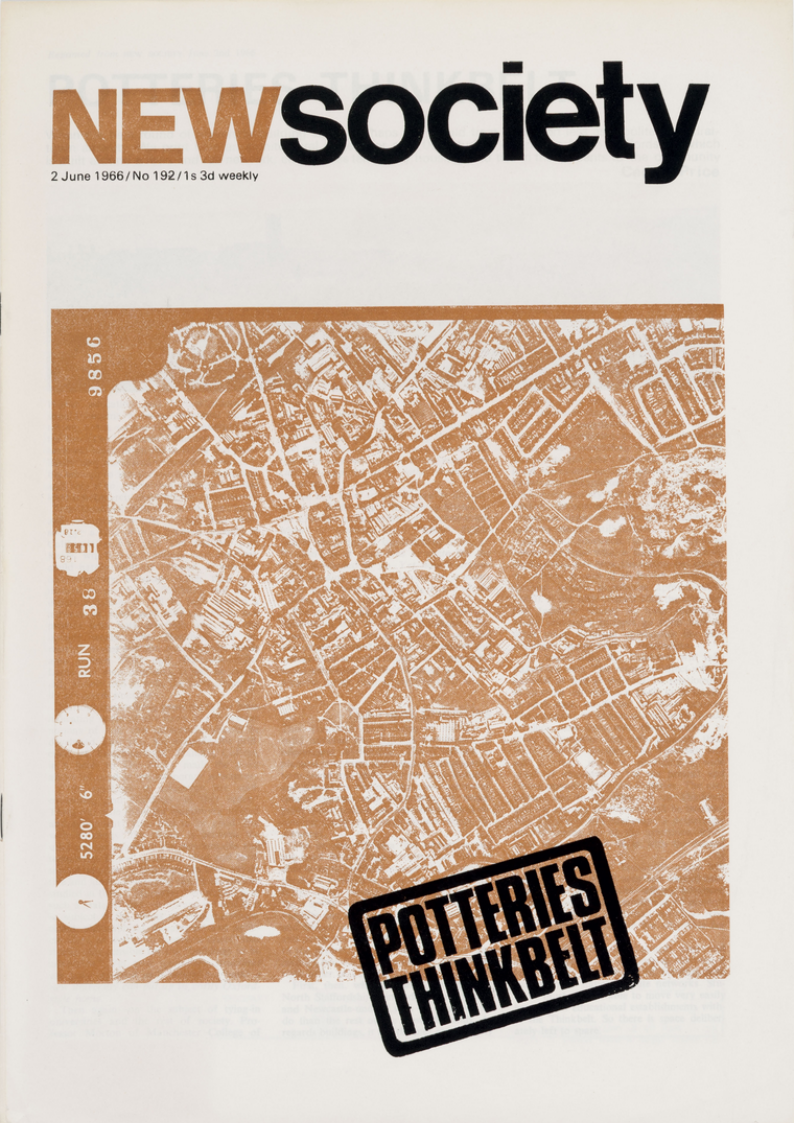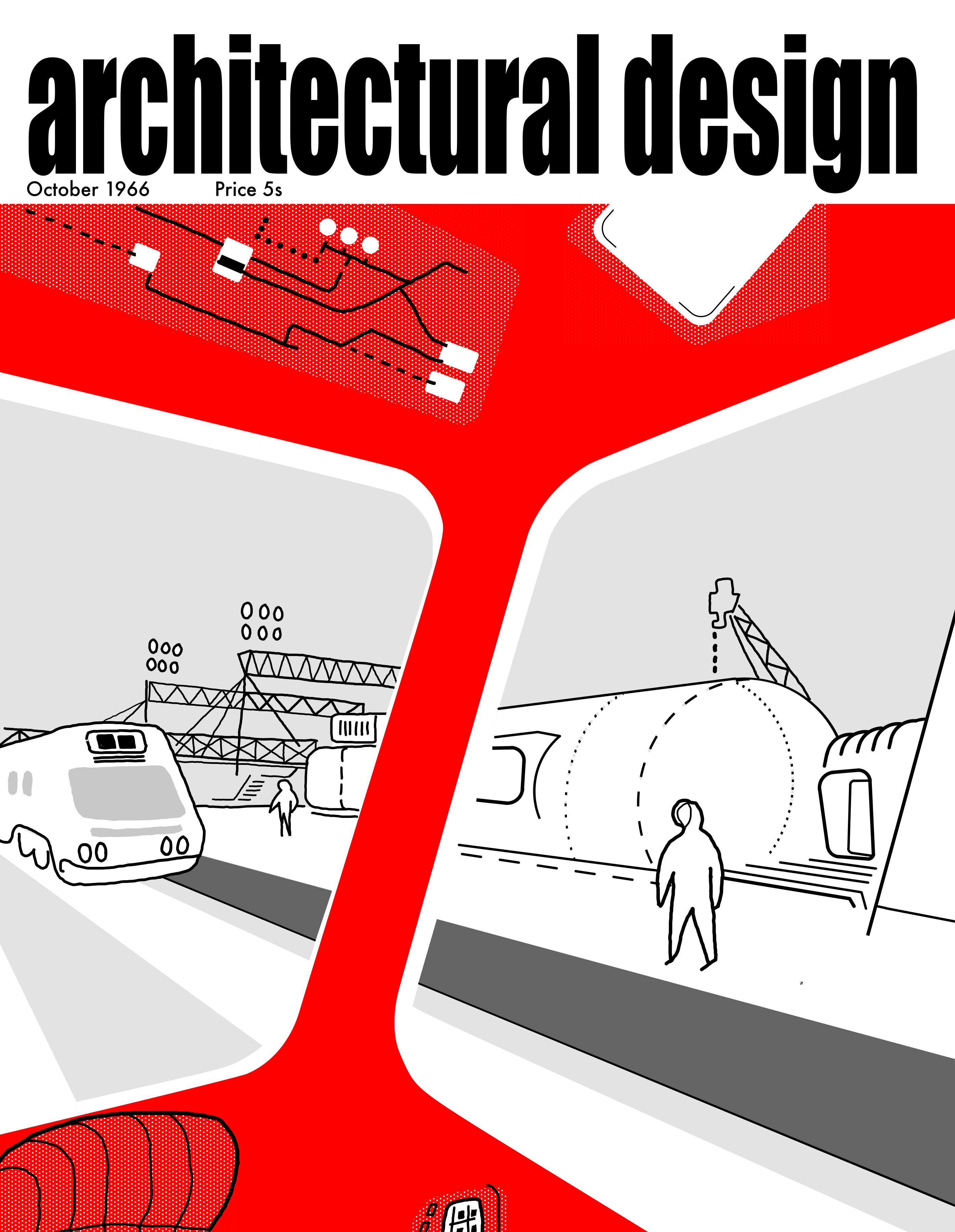Potteries Thinkbelt

|

|
• Covers of New Society, June 1966 (left) and Architectural Design, October 1966 (right).
Contents |
[edit] Introduction
Design of the Potteries Thinkbelt (PTb) started in August 1964. It was published in two different formats:—
- New Society, 2 June 1966;
- Architectural Design, October 1966.
Thus this article assumes:—
- ... that learning can be a sufficient generator of cities; [1]
- ... that anticipation of social change is a necessity. [2]
The prime aim is to enable others to engage in this area of research.
[edit] Original Conception
- "Defence, energy and commerce have in the past been sufficient generators of cities. This project assumes that education and the need to exchange information may have a similar generative force: cities can be made by learning."
- (Cedric Price, 'Potteries Thinkbelt', AD/10/66, p.484).
• Panel 1: 'The Potteries Thinkbelt Study 1964' by Adam Levin (2011)
A thorough review of the literature provides evidence to support the first prong of the argument, namely:—
[edit] Thinkbelt "Now"
- "When we asked Cedric Price if he would consider presenting POTTERIES THINKBELT at a Supercrit in 2003 he asked one question: 'what is the value of it now - what is useful about it now for you?'"
- (Samantha Hardingham, 2007, in 'Supercrit #1' by Samantha Hardingham and Kester Rattenbury).
• Panel 2: 'Supercrit #1', Posted 8th October 2011 by Norman Fellows
- "Supercrit #1 (the book - published in 2007) is effectively a pilot research report.
- The research proposal was "...to plot a provisional thesis of EXP's definition of the term 'experimental' - when applied to architectural practice through the detailed analysis of a specific design proposal - and to present a way in which to explore architectural ideas in an evolving and discursive manner - based on the premise that (in Price's words) 'ideas exist today'."
- The case selected was Supercrit #1 (the event - staged on 5 November 2003) which took Cedric Price's Potteries Thinkbelt - a major experimental project deemed to have `changed the weather' of architectural thought and practice - and put it back into the design studio `crit' format for open public and expert debate. The event was presented by a panel, due to Price's death three months earlier. Speakers included Paul Barker, Paul Finch, Jeremy Melvin, Stephen Mullin and Peter Murray.
- The data produced took the form of facsimiles of the articles published in New Society and Architectural Design in 1966; copies of 7 project illustrations from the Cedric Price fonds at the Canadian Centre for Architecture; and a transcript of the event which includes contributions by the various speakers and ends with a transcript from an exhibition in Madrid in 2000 in which Price began by asking "What is the value of it ... now?" and ended by saying "I think I have said enough."
- The data analysis - as distinct from the detailed analysis of the PTb design proposal found in the transcript - was carried out by Kester Rattenbury and suggests that Price's own description of the PTb should have come first and that what Price said is sufficient to enable us to work out what is necessary.
- I think the report should be continuously updatable."
(Norman Fellows, 2013, 'Review', Amazon UK, July.)
A detailed survey of reviews provides evidence to support the second prong of the argument, namely:—
- ... that anticipation of social change is a necessity.
[edit] Possible Development
- "'Immediate' increase in activity and population*"
- “Possible Thinkbelt development in old industrial net between Nottingham and Sheffield 30-40 miles”.
- (Cedric Price, 1969, 'Non-Plan', Architectural Design, May)
• Panel 3: 'The Dukeries Thinkbelt Study' by Norman Fellows (2015)
- * "It must not become necessary in these proposals and in fact to make estimates (either extrapolatory or by prediction) of long-term growth since this negates the self-adjusting factor implicit in Non-plan"
- (ib.)
A review of the research documents enables other interested parties to pick up the argument, namely:—
- If learning is to be a sufficient generator of cities then anticipation of social change in community and the individual, and in the constructive response of the built environment, is a necessity.
[edit] Conclusion
This article affirms its premises and founds a conditional argument.
It therefore concludes:—
- ... that the Potteries Thinkbelt and the Dukeries Thinkbelt are cities generated by learning; [1]
- ... that both projects recognise the necessity for anticipation of social change. [2]
Thus this article also achieves its aim, namely:—
[edit] Notes
[1] The term 'learning' is defined in this article as 'possession of knowledge got by study' (OED).
[2] The term 'social change' is defined in this article as 'social change in community and the individual, and in the constructive response of the built environment' (Cedric Price, 1999, 'FAX', Canadian Centre for Architecture).
[3] In response to a request from Norman Fellows in 1982, Cedric Price wrote back saying that he had "... no objection (to possible development) as long as due acknowledgement is given to the original conception.”
[edit] References
Panel 1: Levin, A. (2011) 'The Potteries Study 1964', from 'Potteries Thinkbelt – Education, Architecture and a Way Foward', on Extremely Provocative, June.
Panel 2: Experimental Practice (2004) 'Supercrit', deprecated Indexhibit file.
Panel 3: Fellows, N. (2018) 'The Dukeries Study 2015', Unpublished.
[edit] Further Reading
Abel, C. (1972) 'Cultures as complex wholes', Architectural Design, December.
Archiblog (2016) 'Thinkbelt World' Facebook.
Architecture + Design Scotland (2012) 'Cedric Price - The Potteries Thinkbelt, Lecture by Samantha Hardingham', Vimeo.
Aureli, P. V. (2011) ‘Labor and Architecture: Revisiting Cedric Price’s Potteries Thinkbelt‘, Log No.23 (Fall 2011), pp.97-118 (22 pages), Anyone Corporation.
Aureli, P. V. (2015) 'Labour, City and Architecture Cedric Price's Pottery Thinkbelt and the Post' (sic), AA School of Architecture, YouTube.
Bendall, P. (2017) 'Potteries Thinkbelt', Vimeo.
Callaghan, M. (2015) 'Cedric Price - The Potteries Thinkbelt - A City Caused by Learning', Ceramic City Stories.
Canadian Centre for Architecture (2009) 'Potteries Thinkbelt', CCA.
Cervantes, J. (Undated) 'Potteries Thinkbelt by Cedric Price', More Than Green.
East Midlands Economic Planning Council (1966) 'The East Midlands Study', HMSO.
Edukit (2017) 'Thinkbelt Study', 3D Warehouse.
Fellows, N. (2008-2018) 'S8.D064: Dukeries Thinkbelt - Preparatory videos', YouTube.
Fellows, N. (2013) 'A book that changed me: Education Automation by Buckminster Fuller', originally published in Guardian Witness but now only in 'Beyond Supercrit #1: CP: PTb', Blogger.
Fellows, N. (2014) 'Dukeries Thinkbelt: A plan for an advanced educational industry in West Nottinghamshire', early work posted on Blogger.
Fellows, N. (2014-2016) 'Dukeries Thinkbelt', Blogger.
Fellows, N. (2015) 'Beyond Supercrit #1: CP: PTb' Blogger.
Fellows, N. (2015) ''The Fuller Challenge: My First Submission', Beyond Supercrit #1: CP: PTb, Blogger.
Fellows, N. (2016) 'Potteries Thinkbelt by Cedric Price', Blogger.
Fellows, N. (2016) 'Dukeries Thinkbelt', New Society, 2 June, WordPress.
Fellows, N. (2016) 'Dukeries Thinkbelt', Anticipatory Design, October, WordPress.
Fellows, N. (2016) 'Dukeries Thinkbelt', NextFlip.
Fellows, N. (2020) 'Annotated scrapbooks for a series of continuously updated reports' in Fellows, N. (2020) 'The Digital Now', Archiblog, Wordpress.
Fellows, N. (2020) 'Dukeries Thinkbelt', Vimeo.
Fellows, N. (2020) 'The Thinkbelt Now', Thinkbelt, Wordpress.
Hacedor De Trampas (2010) 'Potteries Thinkbelt of Cedric Price', Blogger.
Hardingham. S. (2004) 'Supercrit #1 Review', Architectural Design, May/June.
Hardingham, S. and Rattenbury, K (2007) 'Cedric Price: Potteries Thinkbelt - Supercrit #1', Routledge.
Kovai*, G. (2021) 'Arendt's Break with the Liberal Imaginary of Society', Filozofski vestnik
Landau, R. ed. (1972) 'Complexity', October, Architectural Design.
Landau, R. (1985) ‘Philosophy of enabling: The work of Cedric Price‘, AA Files, No. 8, January, pp. 3-7 – also in Price, C. (1984) ‘Cedric Price Works II’, Architectural Association, pp. 9-15.
Levin, A. (23 June 2011) 'Potteries Thinkbelt - Education, Architecture and a Way Forward', Sputnik Shuffle.
Lobsinger, M. L. (undated) 'Cedric Price: An Architecture of the Performance, Daidolus.
Martin, D. (2014) 'The Thinkbelt: The University that never was', Discover Society.
Mathews, S. (2000) 'Potteries Thinkbelt: an architecture of calculated uncertainty', Hobart & William Smith Colleges.
Mathews, S. (2014) 'Cedric Price - From "Brain Drain" to the "Knowledge Economy"', issuu.
Mathews, S. (2007) 'From Agit Prop to Free Space: The Architecture of Cedric Price', pp.196-197, Scribd.
Museum of Modern Art (2017) 'Cedric Price Potteries Thinkbelt Project, Staffordshire, England (1964-1966)', MoMA - the permanent exhibition includes 10 works illustrating the project.
NORD (2012) 'CP Potteries Thinkbelt Model Railway', YouTube.
Perera, D. (2017) 'What if Cedric Price's "Think Belt" was Built?', Academia.
Prakash, S. S. (2021) 'Potteries Thinkbelt', YouTube.
Price, C. (1966) 'Potteries Thinkbelt', New Society, 2 June, on Wordpress.
Price, C. (1966) 'Potteries Thinkbelt', October, Architectural Design, on Wordpress.
Price, C. et al. (1969) 'Non-Plan', 21 March, New Society.
Price, C. (1969) 'Non-Plan', May, Architectural Design.
Price, C. (1972) 'Approaching an Architecture of Approximation', in Landau, R. ed. (1972) 'Complexity', October, Architectural Design.
Price, C. (1984) 'Cedrid Price: Works II', Architectural Association.
Price, C. (1979) ‘Technology Is The Answer But What Was The Question?’, Technology is the Answer, but what was the Question?, Wordpress.
Price, C. (1999) 'Message (fax) from Cedric Price addressed to the IFCCA Prize Coordinator', IFPRI records, Canadian Centre for Architecture.
Rose, S. (2005) 'Cedric Price', Guardian, 29 June.
Sara (2012) 'Cedric Price's Potteries Thinkbelt', City Movement.
The Potteries (undated) 'People of Stoke-on-Trent: Cedric Price', The Potteries.
Tufnell, R. (2015) 'Potteries Thinkbelt', Rob Tufnell.
University of Cambridge (2014) '"Anti-building" for the future: the world of Cedric Price', accompanying notes to an exhibition at St John's College.
--Archiblog 16:15, 31 Mar 2023 (BST)
[edit] Related articles on Designing Buildings
ATOM: A generating system designed by Cedric Price
Disaster Planning: North Staffs
EDUKIT: World Educational System
Potteries Thinkbelt study: Further ongoing resarch
Featured articles and news
Gregor Harvie argues that AI is state-sanctioned theft of IP.
Many resources for visitors aswell as new features for members.
Using technology to empower communities
The Community data platform; capturing the DNA of a place and fostering participation, for better design.
Heat pump and wind turbine sound calculations for PDRs
MCS publish updated sound calculation standards for permitted development installations.
Homes England creates largest housing-led site in the North
Successful, 34 hectare land acquisition with the residential allocation now completed.
Scottish apprenticeship training proposals
General support although better accountability and transparency is sought.
The history of building regulations
A story of belated action in response to crisis.
Moisture, fire safety and emerging trends in living walls
How wet is your wall?
Current policy explained and newly published consultation by the UK and Welsh Governments.
British architecture 1919–39. Book review.
Conservation of listed prefabs in Moseley.
Energy industry calls for urgent reform.
Heritage staff wellbeing at work survey.
A five minute introduction.
50th Golden anniversary ECA Edmundson apprentice award
Showcasing the very best electrotechnical and engineering services for half a century.
Welsh government consults on HRBs and reg changes
Seeking feedback on a new regulatory regime and a broad range of issues.
CIOB Client Guide (2nd edition) March 2025
Free download covering statutory dutyholder roles under the Building Safety Act and much more.




























Comments
[edit] To make a comment about this article, click 'Add a comment' above. Separate your comments from any existing comments by inserting a horizontal line.